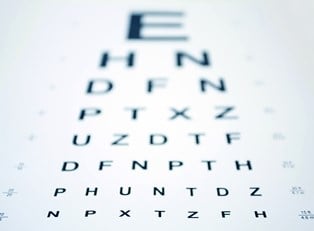A cataract is the clouding of the eye's lens that makes it difficult to see in the dark, read or even notice minor details. Eyes catch light rays through the pupils and focus the rays through the lenses and onto the retina. The lenses focus light onto the retina only if they're clear. Cataracts make it difficult to focus that light.
Symptoms
One of the biggest signs that you may have developed cataracts is cloudy or dim vision. Those who have developed cataracts sometimes describe their vision as a "fogged-up window." If you have noticed it's becoming increasingly difficult to see at night or you experience sensitivity to light, you may be developing a cataract in one or both of your eyes.
It's also common to see double in one eye or to see a ring of light around bright objects, such as a light fixture or television screen, as cataracts develop. These symptoms may start off small and may not bother you all the time, but as the cataract grows, more of your eye's lens may cloud up, making it more difficult to see.
Risk Factors
There are some risk factors that may contribute to the chances of developing cataracts, but most of it has to do with aging. The protein in the eye is what helps keep the lens clear, allowing it to correctly pass light onto the retina. But that protein can clump together as we age, forming the cataract cloud over the lens. Scientists have not come up with a definitive answer as to why this happens.
Besides aging, other risk factors include diabetes, smoking, obesity, and supplemental hormones. Those with a family history of cataracts may be at a higher risk of developing them as well. Ultraviolet radiation can contribute to cataracts as we age. There are also congenital cataracts, which can occur in infants or children, that are also hereditary.
Diagnosis
An ophthalmologist may perform a retinal exam, which requires your pupils to be dilated, to determine if you have developed a cataract. However, sometimes it is a bit more obvious to notice, and a simple vision test may be able to determine a diagnosis. Each eye will be individually tested for sharpness in a visual test. It is important to have an eye exam at least once a year if you are over the age of 60 to determine if you may be developing cataracts.
Treatment
Surgery is the most effective treatment for cataracts, but not everyone who develops them opts for surgery. Doctors tell their patients to consider the surgery if their cataracts are interfering with their daily lives and putting them in danger. You may want surgery if it is becoming too difficult to drive at night, read, or even walk around the house.
During the procedure, the surgeon will remove the clouded lens and replace it with a clear, artificial lens. The artificial lens is place in the same spot as your original lens. This procedure is generally an outpatient procedure, and the patient is given local anesthesia. As with every surgery, there are a few risks, which include bleeding and infection.
If you fear you are developing cataracts, or have been diagnosed with them already and want to discuss treatment options, schedule a consultation with your doctor to determine which treatment plan is best for you and your vision.




